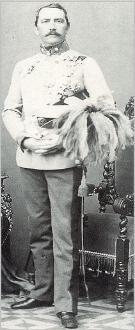Who was the Irishman who rescued the Emperor? Maximilian Karl Lamoral Graf O’Donnell von Tyrconnell (1812-1895) was born in Vienna, a descendant of the Irish noble dynasty of O’Donnell of Tyrconnell and son of Count Maurice O’Donnell (Moritz Graf O’Donnell) (1780-1843). He was educated in Dresden, then joined the military and served in several engagements in Europe, including in Italy in 1848, and Hungary in 1849, resulting in many awards and promotion. He became aide-de-camp to Emperor Franz Josef I.
O’Donnell held a German Habsburg title of Count, granted to his great-grandfather, and after rescuing the Emperor, he was made a Count of the Habsburg Austrian Empire. Maximilian was also honoured with orders of chivalry by several European monarchs, and made a Freeman of the cities of Vienna, Prague, Pest, Laibach and others. He was also conferred with the Commander’s Cross of the Royal Order of Leopold. He died in his home in Salzburg, and is buried in the Salzburg Cemetery. But why was he there in the first place?
Several Irishmen were famous in the Habsburg Empire. Much earlier, in 1634, during the Thirty Years’ War, Irish officers led by Walter Deveraux assassinated general Albrecht von Wallenstein on the orders of the Habsburg Emperor. Then there was the “Flight of the Wild Geese,” which technically refers to the departure of an Irish Jacobite army under the command of Patrick Sarsfield from Ireland to France after the end of the Williamite War in Ireland. But more broadly, the term “Wild Geese” refers to Irish soldiers who left to serve in continental European armies in the 16th, 17th and 18th centuries, or even to Irish soldiers in British armies as late as the First World War.
As well as going into service for the governments of France, Spain and elsewhere, a substantial numbers of Irish officers and men were in the armies of the Austrian Habsburg Empire, many of whom were based in Prague. The most famous of these was Peter Lacy, Russian Field Marshal, whose son Franz Moritz von Lacy excelled in the Austrian service. Also well known is Lacy’s colleague and commanding officer, General Count Maximilian Ulysses von Browne, the Austrian Commander-in-Chief at the Battle of Lobositz.
Austrian field marshal Franz Moritz Graf von Lacy or Lascy 1725 – 1801, was born at St Petersburg to Count Peter Lacy, a Russian Field Marshal who belonged to an Irish family that had followed the exiled James II. Franz Moritz was educated in Germany for a military career before entering the Austrian service. He served in Italy, Bohemia, Silesia and the Netherlands during the War of the Austrian Succession, was twice wounded, and by the end of the war was a lieutenant-colonel. He became full colonel and chief of an infantry regiment at age twenty-five. With the advent of the Seven Years’ War in 1756, he distinguished himself in the first battle (Lobositz) and was promoted major-general, after receiving his third wound. His fourth wound was at the battle of Prague in 1757.
Later that year, he took part in the celebrated victory of Breslau. He was wounded for the fifth time at Leuthen, but covered the retreat of the defeated army. He and others made things difficult for Friedrich the Great for the remainder of the war. Lacy was made quartermaster-general, After Hochkirch on October 15, 1758, Lacy received the Grand Cross of the Order of Maria Theresa. Later, after Maria Theresa placed her son, Emperor Joseph II, at the head of Austrian military affairs, Lacy was made a field marshal, and given the task of reforming and administering the army (1766). He framed new regulations for each arm and a new code of military law. Due to ill health, in 1773, he went to southern France. When Joseph II became Austrian emperor upon Maria Theresa’s death, Lacy remained his most trusted friend. He took part in several more military actions and retired to his castle of Neuwaldegg near Vienna.
